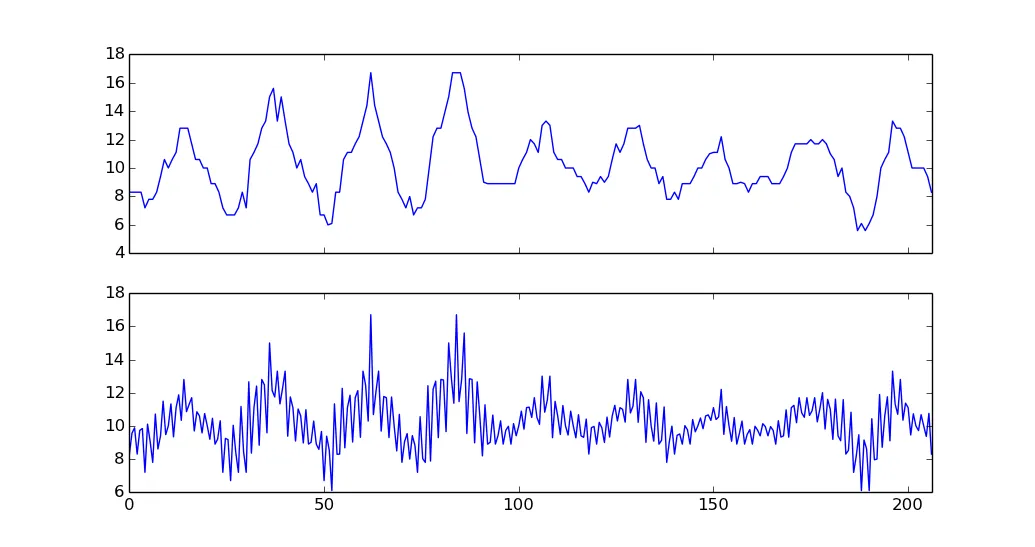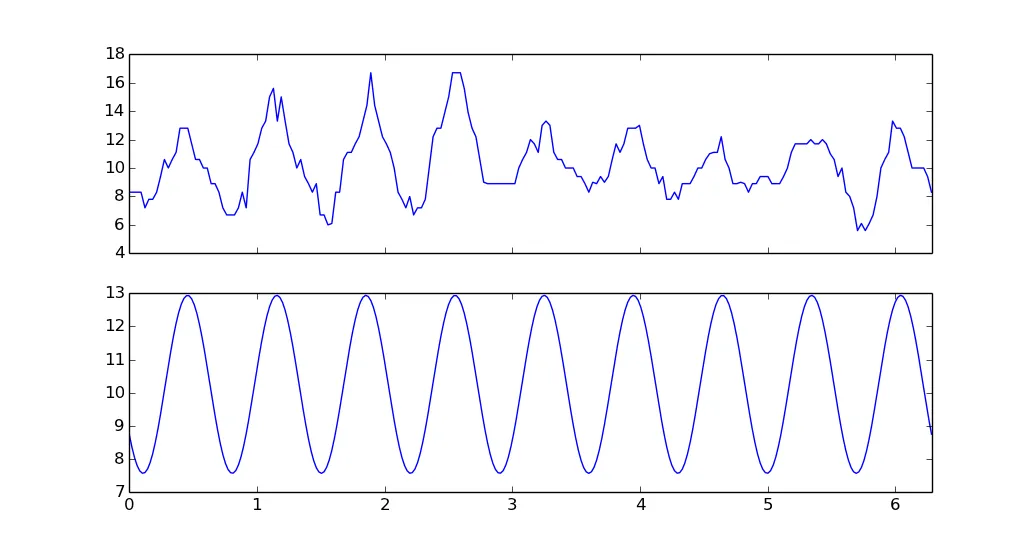我对Python非常陌生。我有一个数据集,想使用numPy/sciPy来预测/推断未来的数据点。是否有一种简单的方法来得到一个数学函数(比如正弦函数),以使其符合我的当前数据,然后我可以通过这个函数传递新值来获取我的预测结果?
以下是我拥有的内容,但我认为它没有达到我想要的效果:
import numpy as np
from scipy.optimize import curve_fit
import matplotlib.pyplot as plt
def main():
y = [8.3, 8.3, 8.3, 8.3, 7.2, 7.8, 7.8, 8.3, 9.4, 10.6, 10.0, 10.6, 11.1, 12.8,
12.8, 12.8, 11.7, 10.6, 10.6, 10.0, 10.0, 8.9, 8.9, 8.3, 7.2, 6.7, 6.7, 6.7,
7.2, 8.3, 7.2, 10.6, 11.1, 11.7, 12.8, 13.3, 15.0, 15.6, 13.3, 15.0, 13.3,
11.7, 11.1, 10.0, 10.6, 9.4, 8.9, 8.3, 8.9, 6.7, 6.7, 6.0, 6.1, 8.3, 8.3,
10.6, 11.1, 11.1, 11.7, 12.2, 13.3, 14.4, 16.7, 14.4, 13.3, 12.2, 11.7,
11.1, 10.0, 8.3, 7.8, 7.2, 8.0, 6.7, 7.2, 7.2, 7.8, 10.0, 12.2, 12.8,
12.8, 13.9, 15.0, 16.7, 16.7, 16.7, 15.6, 13.9, 12.8, 12.2, 10.6, 9.0,
8.9, 8.9, 8.9, 8.9, 8.9, 8.9, 8.9, 8.9, 10.0, 10.6, 11.1, 12.0, 11.7,
11.1, 13.0, 13.3, 13.0, 11.1, 10.6, 10.6, 10.0, 10.0, 10.0, 9.4, 9.4,
8.9, 8.3, 9.0, 8.9, 9.4, 9.0, 9.4, 10.6, 11.7, 11.1, 11.7, 12.8, 12.8,
12.8, 13.0, 11.7, 10.6, 10.0, 10.0, 8.9, 9.4, 7.8, 7.8, 8.3, 7.8, 8.9,
8.9, 8.9, 9.4, 10.0, 10.0, 10.6, 11.0, 11.1, 11.1, 12.2, 10.6, 10.0, 8.9,
8.9, 9.0, 8.9, 8.3, 8.9, 8.9, 9.4, 9.4, 9.4, 8.9, 8.9, 8.9, 9.4, 10.0,
11.1, 11.7, 11.7, 11.7, 11.7, 12.0, 11.7, 11.7, 12.0, 11.7, 11.0, 10.6,
9.4, 10.0, 8.3, 8.0, 7.2, 5.6, 6.1, 5.6, 6.1, 6.7, 8.0, 10.0, 10.6, 11.1,
13.3, 12.8, 12.8, 12.2, 11.1, 10.0, 10.0, 10.0, 10.0, 9.4, 8.3]
x = np.array(np.arange(len(y)))
fitting_parameters, covariance = curve_fit(fit, x, y)
a = fitting_parameters[0]
b = fitting_parameters[1]
c = fitting_parameters[2]
d = fitting_parameters[3]
for x_predict in range(len(y) + 1, len(y) + 24):
next_x = x_predict
next_y = fit(next_x, a, b, c, d)
print("next_x: " + str(next_x))
print("next_y: " + str(next_y))
y.append(next_y)
plt.plot(y)
plt.show()
def fit(x, a, b, c, d):
return a*np.sin(b*x + c) + d
我尝试使用curve_fit和univariatespline来处理我的数据,但这两种方法只是分别适应了我的当前数据并平滑了我的点。我的问题是,这些工具只是“拟合”了我的数据,而没有给我一个可以用来获取未来数据点的函数。
我认为我可以使用离散傅里叶变换,因为我的数据是周期性的,看起来可以描述为正弦和余弦的总和。但是一旦我从时域得到频率域,我就不知道如何进行“外推”,以便预测时间域中的未来周期和数据点。
import numpy as np
import matplotlib.pyplot as plt
mydata = [8.3, 8.3, 8.3, 8.3, 7.2, 7.8, 7.8, 8.3, 9.4, 10.6, 10.0, 10.6, 11.1, 12.8,
12.8, 12.8, 11.7, 10.6, 10.6, 10.0, 10.0, 8.9, 8.9, 8.3, 7.2, 6.7, 6.7, 6.7,
7.2, 8.3, 7.2, 10.6, 11.1, 11.7, 12.8, 13.3, 15.0, 15.6, 13.3, 15.0, 13.3,
11.7, 11.1, 10.0, 10.6, 9.4, 8.9, 8.3, 8.9, 6.7, 6.7, 6.0, 6.1, 8.3, 8.3,
10.6, 11.1, 11.1, 11.7, 12.2, 13.3, 14.4, 16.7, 14.4, 13.3, 12.2, 11.7,
11.1, 10.0, 8.3, 7.8, 7.2, 8.0, 6.7, 7.2, 7.2, 7.8, 10.0, 12.2, 12.8,
12.8, 13.9, 15.0, 16.7, 16.7, 16.7, 15.6, 13.9, 12.8, 12.2, 10.6, 9.0,
8.9, 8.9, 8.9, 8.9, 8.9, 8.9, 8.9, 8.9, 10.0, 10.6, 11.1, 12.0, 11.7,
11.1, 13.0, 13.3, 13.0, 11.1, 10.6, 10.6, 10.0, 10.0, 10.0, 9.4, 9.4,
8.9, 8.3, 9.0, 8.9, 9.4, 9.0, 9.4, 10.6, 11.7, 11.1, 11.7, 12.8, 12.8,
12.8, 13.0, 11.7, 10.6, 10.0, 10.0, 8.9, 9.4, 7.8, 7.8, 8.3, 7.8, 8.9,
8.9, 8.9, 9.4, 10.0, 10.0, 10.6, 11.0, 11.1, 11.1, 12.2, 10.6, 10.0, 8.9,
8.9, 9.0, 8.9, 8.3, 8.9, 8.9, 9.4, 9.4, 9.4, 8.9, 8.9, 8.9, 9.4, 10.0,
11.1, 11.7, 11.7, 11.7, 11.7, 12.0, 11.7, 11.7, 12.0, 11.7, 11.0, 10.6,
9.4, 10.0, 8.3, 8.0, 7.2, 5.6, 6.1, 5.6, 6.1, 6.7, 8.0, 10.0, 10.6, 11.1,
13.3, 12.8, 12.8, 12.2, 11.1, 10.0, 10.0, 10.0, 10.0, 9.4, 8.3]
sp = np.fft.rfft(mydata)
freq = np.fft.rfftfreq(len(mydata), d= 1.0)
plt.subplot(211)
plt.plot(mydata)
plt.subplot(212)
plt.plot(freq, sp, 'r')
plt.show()
我知道外推可能是危险和不可靠的,但是为了这个项目的目的,我只是想得到一个可以绘制函数图形的工作预测功能。
非常感谢您的帮助。

